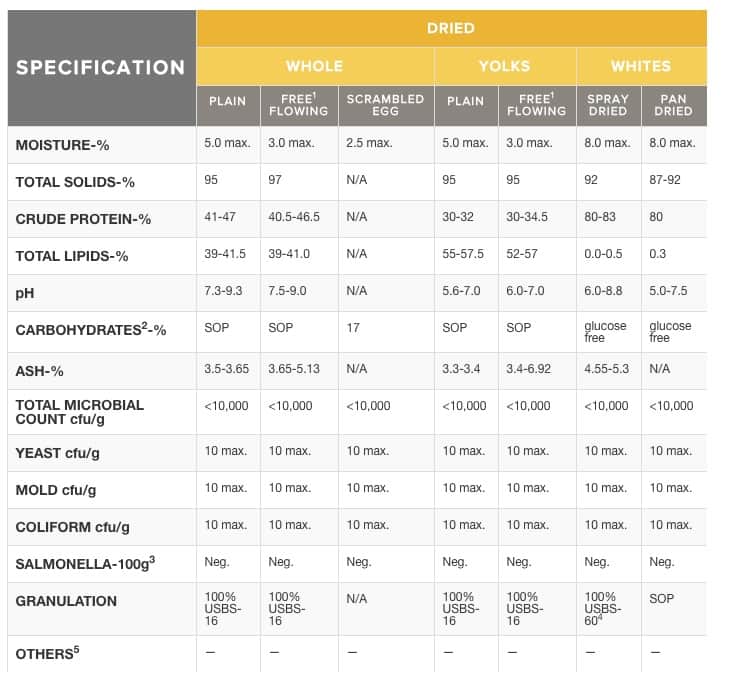Whole Egg Types
DRIED WHOLE EGG
With dried whole eggs, most of the moisture is removed, providing product developers with a highly concentrated egg product. Dried whole egg is typically spray dried. Sucrose, corn syrup or sodium silicoaluminate are sometimes added as anti-caking agents to assure a free flowing product. Without these ingredients, the dried whole egg product could harden and solidify, making it difficult to incorporate into food systems. These ingredients also help preserve the whipping properties of dried whole egg. Dried whole eggs have the advantage of long shelf life and stability and are easily mixed with other ingredients.
Dried whole egg products are virtually indistinguishable from fresh eggs, as well as refrigerated and frozen egg products, in terms of nutritional value, flavor, and most functional properties. These qualities are well retained during proper storage.
REFRIGERATED LIQUID/FROZEN WHOLE EGG
Whole eggs, or simply eggs, are composed of two distinct parts — the albumen, or white, and the yolk, or yellow — with each part providing different and important nutrients and functionalities. From the nutritional side, whole eggs are considered nutrient dense.
A 50‐gram egg (average weight of a large egg) contains 6.25 grams of protein, which is high‐quality, complete protein, 5 grams of fat, the majority of which is unsaturated, and contains lots of essential vitamins and minerals. Thus, using eggs in a prepared food formulation helps build an attractive Nutrition Facts label. And of course, the natural and wholesome reputation of eggs is well received by consumers when eggs appear on ingredient statements. Functionally, eggs provide prepared foods with exceptional richness, in terms of flavor, color and texture. They can be used to assist in emulsifying, stabilizing, increasing volume, and improving machineability. Food formulators get all this from just one simple, all‐natural ingredient —the egg.
Whole liquid eggs not only simplify the production of foods made with eggs, they provide consistency in measurement and ensure safety and quality. Prepared foods production facilities never have to deal with shelling eggs. There is no waste from breakage, which reduces production costs. The whole liquid egg product is ready to use. Plus, the person measuring ingredients does so by either volume (e.g., one gallon) or weight (50 pounds), depending on application and batch size. Often times egg product suppliers will sell pre‐measured containers of whole liquid egg products for even easier incorporation into formulations. There’s less labor and less room for error.
Lastly, whole liquid eggs are pasteurized to destroy Salmonella and other bacteria, which ensures safety. Typically, shell eggs, once cleaned and broken, are separated into whites and yolks. The whites and yolks are separately pasteurized. If whole liquid egg product is being made, pasteurized egg whites and egg yolks from the same production batch are blended together in their entirety, in natural proportions. Egg products produced by combining whites and yolks from different production batches cannot be labeled as whole eggs. These products must be identified with an ingredient statement showing the content of the product as egg whites and egg yolks.
AVAILABILITY
DRIED WHOLE EGG
- Blends of Whole Egg and/or Yolk with Carbohydrates (Sugar or Corn Syrup)
- Enzyme Modified Whole Egg Solids
- Free-Flowing Whole Egg Solids (with free-flow agent added)
- Stabilized (glucose-free) Whole Egg Solids
- Whole Egg Solids
REFRIGERATED LIQUID/FROZEN WHOLE EGG
- Whole Eggs
- Whole Eggs and Yolks with Corn Syrup
- Whole Eggs with Citric Acid
- Whole Eggs with Corn Syrup
- Whole Eggs
- Whole Eggs with Salt
- Whole Eggs with Sugar
- Whole Eggs with Yolk Added
- Extended Shelf Life Whole Eggs
STORAGE
DRIED WHOLE EGG
Plain unstabilized whole egg solids have a shelf life of about one month at room temperature and about a year at refrigerated temperatures. If stabilized, the shelf life increases to one year at room temperatures.
Dried whole egg solids should be kept cool, less than 50°F (10°C) to maintain quality. Once containers of egg solids have been opened, they should be resealed tightly to prevent contamination and absorption of moisture. If dried eggs are combined with dry ingredients and held for storage, they should be sealed tightly in a closed container and stored in the refrigerator at 32° to 50°F (0° to 10°C).
REFRIGERATED LIQUID/FROZEN WHOLE EGG
Refrigerated products should be kept at 40°F (4°C) or below. Frozen products should be stored at 0°F (-17°C) or below and show no signs of having been thawed. Thaw egg products in the refrigerator, or under cold running water. Use well within expiration dates.
PRODUCT CONVERSION
Use this chart to convert refrigerated/frozen egg products to shell or dried egg products.

STORAGE
Dried whole egg solids should be kept cool at less than 50°F (10°C) to maintain quality. Once containers of egg solids have been opened, reseal tightly to prevent contamination and absorption of moisture. And once dried eggs are reconstituted, use immediately or store refrigerated for no more than four days.
If dried eggs are combined with dry ingredients and held for storage, they should be sealed tightly in a closed container and stored in the refrigerator at 32° to 50°F (0° to 10°C). Plain unstabilized whole egg solids have a shelf life of about one month at room temperature and about a year at refrigerated temperatures. Store dried eggs as any other dried, powdered food in a cool, dark place. Dried egg products should ow freely and not be clumped or hardened. Use well within expiration dates.
Specifications for Dried Eggs

References
- Free-flowing products contain less than 2% sodium silicoaluminate.
- Most dried egg whites are desugared. Whole egg and yolk products are desugared if specified on purchase (SOP).
- Negative by USDA approved testing procedures.
- U.S. Bureau of Standards.
- Additives and performance specifications may be specified on purchase.
